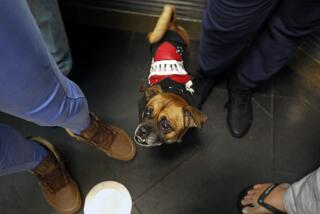The Bird Lady of Echo Park
- Share via
The far backyard of the house of my childhood was a Flanders Field of briefly mourned dead things. Rows and rows of Popsicle-stick crosses marked the places of Easter chicks--pink- and blue-dyed and soon thereafter dead, of dime-store turtles and mail-order lizards and bellied-up goldfish.
We buried, too, the found corpses of infant birds fallen from nests and of bigger birds stalked instinctively by cats and maliciously by bullies with pellet guns. I thought of them in after-years, when I came upon a line by a dead Greek poet named Bion:
Though boys throw stones at frogs in sport, the frogs do not die in sport, but in earnest.
Perhaps it was just as well that the wild things were already dead when I found them, or I might have fed them on bread and milk--as useless as feeding beefsteak to a newborn--and then grown resentful when they died in spite of my ministrations.
But then, there were always more turtles at the dime store, weren’t there, always more birds in the sky?
All this I was compelled to confess, all these years later, to Diane Waters, the Bird Lady of Echo Park. Something clean and fierce in the wild birds recovering from the ravages of California life in her California bungalow clinic demands truth-telling. There is a ferocity and a cleanness in Waters, too, which the term “bird lady” trivializes, implying as it does a snuggly-wuggly coziness--”woozling,” she calls it--with her feathered charges, a corrupting Disneymorphizing of wild creatures that is the ruination of them.
This 47-year-old nurse is not reluctant to scold a mother who calls for advice now that her 9-year-old daughter has “bonded” with a fallen sparrow and is mature enough to care for it. Are 9-year-olds mature enough for the death experience? Waters asks. Because that’s what’s going to happen.
I feel a deja vu blush. While I was a 9-year-old who expected gratitude from my salvaged creatures--like the birdies that twittered on Snow White’s digits--Waters wants fear and ferocity from her rescued creatures. For those, and not woozling, are the means to survival.
Her arms, like those of ancient warrior-kings, are scratched and scarred from her victories. A bird of prey that lands “soft” is not a bird that will make it in the wild. She doses her punctures and bloody furrows with her own spit and works on--2,800 birds last year--hawks, kestrels, owls, songbirds, herons, in incubators and playpens and flight cages, bringing her diagnostic acuity and surgical skill to their grievous encounters with humans’ cats and guns and car grilles and plate glass, making them not loving of us but wary. “I am not,” she says, “after their souls.”
She lives with her doctor-husband--the one who funds 90% of the $30,000-a-year salvage operation--and her birds du jour in a 1913 bungalow in Echo Park. One year after it was built, Martha, the last passenger pigeon, died in the Cincinnati zoo, the last of 5 billion whose flocks had darkened American skies for a hundred years before. It was as unimaginable as if the last ant or flower had died.
Multi-culti Los Angeles has about 450 bird varieties but precious few of each. Nesting places disappear; trees are hacked down, the arroyo is filled with a freeway, the L.A. River is at risk.
Waters worries that her sanctuary is at risk, too. The ways of humans and their governments can work at cross-purposes. Her dozen years’ work may be undone by one complaint. Operating under federal, state and city permits, she has been told by the county that she has until January to shut down a remarkable operation, because the health code prohibits anything but cats, dogs, canaries and similar birds in any home, which ought to alarm the owners of rabbits, lizards, pet pigs and hamsters.
As Waters does not sell her work on cuddly sentiment, neither will I: A hawk eats one rat a day. Last year she released 270 hawks back into the wild; 270 hawks times 365 days is--let me see--a helluva lot of disappeared rats.
Everything is here for a reason. To kill off a species is like taking a rivet out of a 747. Each lost species is a lost rivet. The jet of earthly biology can fly without 10 rivets, or 100, or maybe 1,000, but the day will come when the critical rivet is lost, and the plane blows apart and takes everything with it, including us.
*
Like a good mother, Diane Waters succeeds when her charges leave home and thrive. The ones she keeps have been irredeemably imprinted by humans: Dad, the great horned owl, half-blind but still capable of laying his talons into her, to the delight of schoolchildren; the one-eyed kestrel, pitiable evidence of the need for her don’t-shoot-it-if-you-won’t-eat-it rule, and Emily, the handsome Chihuahuan raven, incapable of flight.
It was only after I drove away that I wondered, too late, about Emily, and whether she had been named for another Emily, now as dead and vanished as the passenger pigeon, who wrote once that hope is the thing with feathers.
More to Read
Sign up for Essential California
The most important California stories and recommendations in your inbox every morning.
You may occasionally receive promotional content from the Los Angeles Times.














